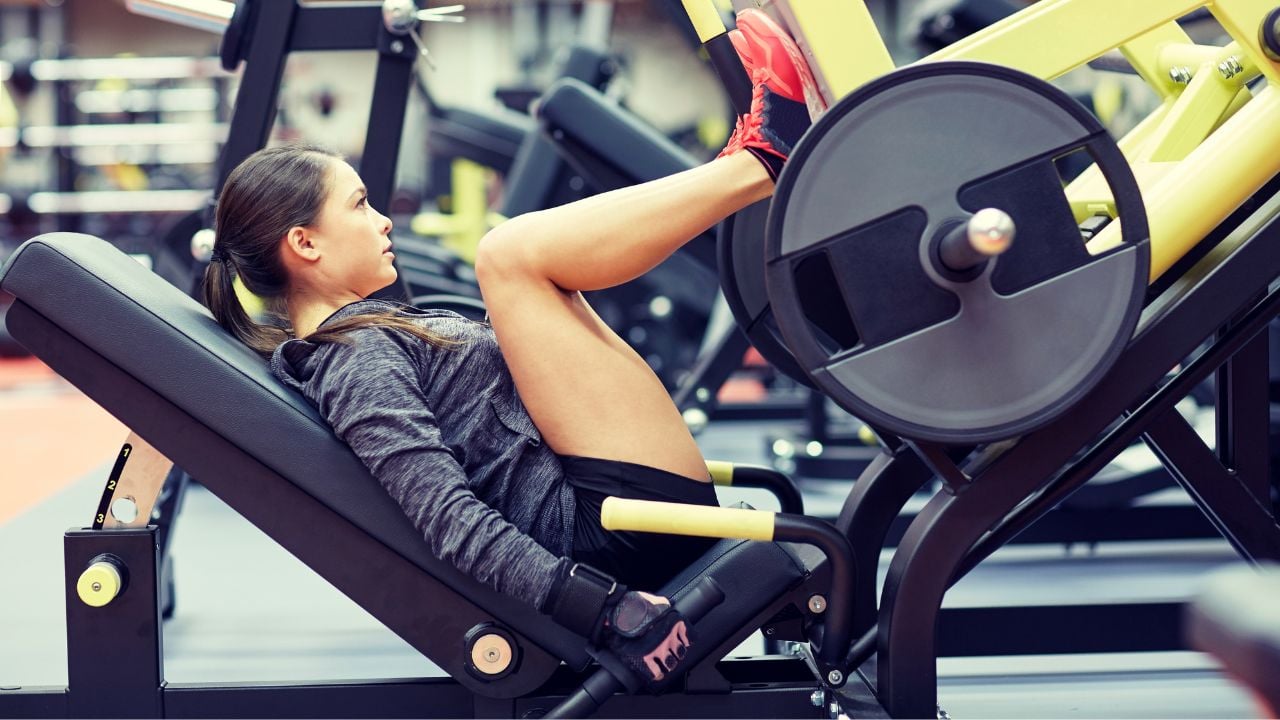Leg Press 1RM Calculator
Calculate your Leg Press One Rep Max (1RM) using scientifically validated formulas. Get personalized leg press training recommendations and percentage-based workout plans optimized for maximum lower body strength and muscle development.

Leg Press One Rep Max (1RM) Training
The Leg Press One Rep Max (1RM) represents the maximum weight an individual can press for a single repetition with proper form. According to research published in the Journal of Strength and Conditioning Research, leg press exercises demonstrate significant muscle activation patterns across different variations. The study analyzed muscle activation during different leg press exercises at submaximum effort levels, revealing that mechanical changes and loads significantly affect lower limb muscle activity patterns.
Biomechanical Analysis
Electromyographic research from the International Journal of Environmental Research and Public Health demonstrates that leg press variations produce different muscle activation patterns. The research shows that foot position and execution velocity significantly influence muscle activation and kinematic parameters during inclined leg press exercises. Understanding these biomechanical differences is crucial for optimizing training programs and 1RM development across different leg press variations.
Machine Variations Impact
Recent research in Applied Sciences explores how different leg press machine configurations affect force production and muscle recruitment patterns. The study reveals that 45-degree leg press machines provide optimal biomechanical advantage for maximum force production, while horizontal and vertical variations offer unique training benefits. This research is fundamental for understanding how machine type affects 1RM calculations and training outcomes.
Athletic Performance Correlation
Leg press 1RM strongly correlates with functional lower body strength and athletic performance. The controlled environment of leg press machines allows for safe maximum loading while minimizing injury risk compared to free weight alternatives. Elite athletes typically demonstrate leg press 1RM values ranging from 2.5-4.0 times body weight, depending on sport-specific demands and training specialization.
Leg Press Variations & 1RM Relationships
| Leg Press Variation | % of 45° Leg Press 1RM | Primary Muscles | Difficulty Level | Best For |
|---|---|---|---|---|
| 45° Leg Press | 100% | Quads, glutes, hamstrings | Moderate | Maximum strength, mass |
| Horizontal Leg Press | 90-95% | Quadriceps emphasis | Moderate | Quad development |
| Vertical Leg Press | 110-115% | Full leg development | Low | Beginners, rehabilitation |
| Single Leg Press | 55-65% (per leg) | Unilateral strength | High | Balance, imbalance correction |
| Hack Squat | 75-85% | Quads, glutes | High | Squat-like movement |
| Smith Machine Squat | 80-90% | Compound movement | Moderate | Controlled squatting |
Variation Selection Strategy
Choose leg press variations based on training goals, experience level, and available equipment. 45-degree leg press provides the most comprehensive strength assessment and allows for maximum loading. Horizontal variations emphasize quadriceps development, while vertical presses are excellent for beginners. Single-leg variations address imbalances and provide unilateral strength development essential for athletic performance.
Leg Press 1RM Strength Standards
Male Leg Press 1RM Standards (kg)
| Body Weight | Beginner | Novice | Intermediate | Advanced | Elite |
|---|---|---|---|---|---|
| 60kg | 120kg | 180kg | 240kg | 320kg | 400kg |
| 70kg | 140kg | 210kg | 280kg | 370kg | 460kg |
| 80kg | 160kg | 240kg | 320kg | 420kg | 520kg |
| 90kg | 180kg | 270kg | 360kg | 470kg | 580kg |
| 100kg | 200kg | 300kg | 400kg | 520kg | 640kg |
Female Leg Press 1RM Standards (kg)
| Body Weight | Beginner | Novice | Intermediate | Advanced | Elite |
|---|---|---|---|---|---|
| 50kg | 80kg | 120kg | 160kg | 220kg | 280kg |
| 60kg | 100kg | 150kg | 200kg | 270kg | 340kg |
| 70kg | 120kg | 180kg | 240kg | 320kg | 400kg |
| 80kg | 140kg | 210kg | 280kg | 370kg | 460kg |
| 90kg | 160kg | 240kg | 320kg | 420kg | 520kg |
Standards Interpretation
These leg press 1RM standards are based on extensive strength data from recreational to competitive lifters, assuming proper 45-degree leg press technique. Standards consider factors including training experience, body composition, and limb proportions. Individual variations exist based on leg length ratios, training history, and genetic factors. Use these standards as general guidelines for setting realistic strength goals and tracking progress over time.
Leg Press 1RM Periodization Model
| Training Phase | Duration | Intensity (%1RM) | Volume (Reps) | Sets | Rest Period | Primary Adaptation |
|---|---|---|---|---|---|---|
| Anatomical Adaptation | 4-6 weeks | 50-70% | 15-25 | 2-3 | 1-2 min | Technique, endurance |
| Hypertrophy | 4-6 weeks | 65-80% | 8-15 | 3-4 | 2-3 min | Muscle growth |
| Maximum Strength | 4-6 weeks | 80-95% | 1-6 | 4-6 | 3-5 min | Neural adaptation |
| Power | 3-4 weeks | 30-60% | 3-8 | 3-5 | 3-5 min | Rate of force development |
| Peaking | 2-3 weeks | 85-100% | 1-3 | 3-5 | 3-5 min | Competition preparation |
| Recovery | 1-2 weeks | 40-60% | 12-20 | 2-3 | 1-2 min | Active recovery |
Periodization Benefits for Leg Press
Systematic periodization of leg press training produces superior strength and hypertrophy gains compared to non-periodized approaches. The leg press responds particularly well to volume periodization models due to the high loading capacity and reduced fatigue compared to free weights. Proper periodization also allows for optimal recovery while maintaining training stimulus for continuous adaptation.
Advanced Leg Press Training Techniques
Pause Leg Press
Protocol: 2-3 second pause at bottom position
Benefits: Increased time under tension, strength off the chest
Pause leg press eliminates the stretch-shortening cycle, requiring greater strength and control. Use 85-95% of regular
leg press 1RM for pause variations. Excellent for building strength in the lengthened position and improving control.
Partial Range of Motion
Method: Top-half or bottom-half range of motion
Benefits: Overload specific ranges, overcome sticking points
Partial ROM leg press allows for supramaximal loading in specific ranges. Top-half partials can handle 110-130% of full ROM 1RM,
while bottom-half partials target the most challenging portion of the movement.
Foot Position Variations
Setup: High, low, wide, narrow foot positions
Benefits: Target different muscle groups, address weaknesses
Different foot positions alter muscle activation patterns. High foot position emphasizes glutes and hamstrings,
while low position targets quadriceps. Wide stance activates more glutes, narrow stance focuses on quadriceps.
Frequently Asked Questions
How often should I test my leg press 1RM?
Beginners: Every 8-12 weeks during strength phases
Intermediate: Every 6-8 weeks or at mesocycle transitions
Advanced: Every 4-6 weeks during peaking phases
Powerlifters: 2-4 weeks before competition
Leg press 1RM testing can be performed more frequently than free weight exercises due to the controlled, safe environment of the machine.
What’s the proper leg press 1RM testing protocol?
Warm-up Protocol:
1. General warm-up: 10-15 minutes dynamic movement
2. Leg-specific activation and mobility work
3. Bodyweight squats and lunges
4. 40% 1RM × 15 reps
5. 60% 1RM × 10 reps
6. 80% 1RM × 5 reps
7. 90% 1RM × 2 reps
8. 100%+ 1RM attempts
Rest 3-5 minutes between heavy sets, ensure safety stops are properly positioned.
What are common leg press 1RM testing mistakes?
Avoid These Errors:
• Insufficient range of motion or partial reps
• Improper safety stop positioning
• Testing when legs are fatigued from previous training
• Allowing knees to cave inward under maximum load
• Rushing through warm-up sets
• Testing too frequently (more than every 4 weeks)
• Poor foot positioning or unstable setup
How does leg press 1RM relate to other exercises?
Typical Strength Ratios:
• Back Squat: 60-75% of leg press 1RM
• Front Squat: 50-65% of leg press 1RM
• Deadlift: 70-85% of leg press 1RM
• Body Weight: 2.5-4.0x for males, 2.0-3.5x for females
These ratios vary based on training specialization, limb proportions, and individual strengths. Leg press typically allows
for higher absolute loads due to the supported, stable position.
What safety features are essential for leg press 1RM testing?
Essential Safety Features:
• Properly functioning safety stops or catches
• Secure foot plate and back support
• Emergency release mechanisms
• Spotter or training partner for assistance
• Proper machine maintenance and inspection
Never attempt maximum leg press without proper safety stops engaged and functioning correctly.
Leg Press Safety & Injury Prevention
Pre-Press Mobility Requirements
Essential Mobility Areas:
• Hip flexion: 120+ degrees for full range of motion
• Ankle dorsiflexion: 30+ degrees for proper foot position
• Knee tracking: Proper alignment throughout movement
• Lumbar spine: Maintain neutral position against back pad
Address mobility limitations before attempting heavy leg press. Poor mobility leads to compensations and increased injury risk.
Common Leg Press Injuries & Prevention
Injury Prevention Strategies:
• Knee injuries: Proper tracking, avoid knee valgus
• Lower back strain: Maintain back contact with pad
• Hip impingement: Respect individual range of motion
• Foot/ankle issues: Secure foot position, proper shoes
Most leg press injuries result from excessive range of motion, improper foot position, or machine malfunction rather than the exercise itself.
Post-Press Recovery Protocol
Recovery Strategies:
• Immediate: Light walking, gentle stretching
• 24 hours: Contrast therapy, protein intake
• 48 hours: Assess muscle soreness, light movement
• Return to training: Gradual load progression
Heavy leg press sessions require 48-72 hours recovery for optimal adaptation, though the controlled nature allows for
more frequent training compared to free weight alternatives.
Related
- Barbell Racking Calculator
- Push-Up Weight Calculator
- Wilks Calculator
- DOTS Calculator
- One-Rep (1RM) Max Calculator
- One-Rep Max (1RM) Bench Press Calculator
References
- Da Silva EM, Brentano MA, Cadore EL, De Almeida AP, Kruel LF. Analysis of muscle activation during different leg press exercises at submaximum effort levels. J Strength Cond Res. 2008 Jul;22(4):1059-65. doi: 10.1519/JSC.0b013e3181739445. PMID: 18545207.
- Martín-Fuentes I, Oliva-Lozano JM, Muyor JM. Evaluation of the Lower Limb Muscles’ Electromyographic Activity during the Leg Press Exercise and Its Variants: A Systematic Review. Int J Environ Res Public Health. 2020 Jun 27;17(13):4626. doi: 10.3390/ijerph17134626. PMID: 32605065; PMCID: PMC7369968.
- Jorge, P., & Abraldes, J. A. (2023). Comparative Electromyographic Analysis in Leg Press of Traditional Fitness Equipment, Traditional Outdoor Fitness Equipment, and a New Model of Outdoor Fitness Equipment in Trained Young Men. Applied Sciences, 14(16), 7390. https://doi.org/10.3390/app14167390
- Knutzen, Kathleen; Brilla, Lorraine; Caine, Dennis (August 1999). “Validity of 1RM Prediction Equations for Older Adults”. The Journal of Strength & Conditioning Research. 13 (3): Vol 13, Issue 3, Page 242–246. Retrieved 11 July 2014.
- Epley, Boyd (1985). “Poundage Chart”. Boyd Epley Workout. Lincoln, NE: Body Enterprises. p. 86.
- Brzycki, Matt (1998). A Practical Approach To Strength Training. McGraw-Hill.
- Kemmler, Wolfgang K.; Lauber, Dirk; Wassermann, Alfred; Mayhew, Jerry L. (2006-11-01). “Predicting maximal strength in trained postmenopausal woman”. Journal of Strength and Conditioning Research. 20 (4): 838–842.

Manish is a NASM-certified fitness and nutrition coach with over 10 years of experience in weight lifting and fat loss fitness coaching. He specializes in gym-based training and has a lot of knowledge about exercise, lifting technique, biomechanics, and more.
Through “Fit Life Regime,” he generously shares the insights he’s gained over a decade in the field. His goal is to equip others with the knowledge to start their own fitness journey.
